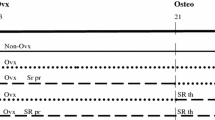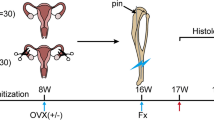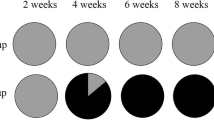Abstract
Most models of osteoporotic bone fractures are performed unilaterally (UL). We investigated healing of tibia osteotomy performed either UL or bilaterally (BL) in ovariectomized rats. Behavior of animals and muscle structure were assessed. Three-month-old female Sprague-Dawley rats were ovariectomized (n = 32). After 10 weeks, half the rats underwent UL osteotomy of tibia metaphysis (right limb) with plate osteosynthesis. The other rats were osteotomized BL. Half of the rats in each group received either standard pain treatment with carprofen (5 mg/kg body weight (BW), 1x/day for 2 days) or carprofen and buprenorphine (5 mg/kg BW, 1x/day and 0.03 mg/kg BW, 2x/day for 5 days) after osteotomy. The UL rats started to load the injured limb from day 27 ± 9; BL rats did this from day 4 ± 4 onward. The UL rats more frequently loaded only one hind limb; BL rats more often loaded both hind limbs. Osteotomy was not bridged in 20% of UL rats and in 4% of BL rats. Callus volume and bone volume fraction were lower in UL group. Weight and fiber size of UL-intact limb muscles were enhanced, compared to the osteotomized limb and those in BL group. Most of the other parameters which assess physiology, activity, body posture, head, or coat were not different. The effect of two pain therapies was not significant on any variable studied. Welfare of the animals was acceptable in all rats. In UL rats, bone healing was delayed. The more advanced healing in BL rats suggested a positive effect of earlier loading. In studies on bone healing, it is advisable to perform BL osteotomy.




Similar content being viewed by others
References
Augat P, Simon U, Liedert A, Claes L (2005) Mechanics and mechano-biology of fracture healing in normal and osteoporotic bone. Osteoporosis Int 16:S36-S43
Histing T, Garcia P, Holstein JH, Klein M, Matthys R, Nuetzi R et al (2011) Small animal bone healing models: standards, tips, and pitfalls results of a consensus meeting. Bone 49:591–599
Kalu DN (1991) The ovariectomized rat model of postmenopausal bone loss. Bone Miner 15:175–192
Lelovas PP, Xanthos TT, Thoma SE, Lyritis GP, Dontas IA (2008) The laboratory rat as an animal model for osteoporosis research. Comp Med 58:424–430
Garcia P, Histing T, Holstein JH, Klein M, Laschke MW, Matthys R et al (2013) Rodent animal models of delayed bone healing and non-union formation: a comprehensive review. Eur Cell Mater 26:1–14
Kalpakcioglu BB, Morshed S, Engelke K, Genant HK (2008) Advanced imaging of bone macrostructure and microstructure in bone fragility and fracture repair. J Bone Joint Surg Am 90(Suppl 1):68–78
Brandi ML (2009) Microarchitecture, the key to bone quality. Rheumatology 48:iv3–iv8
Johnell O, Kanis JA (2006) An estimate of the worldwide prevalence and disability associated with osteoporotic fractures. Osteoporos Int 17:1726–1733
Kanis JA, Oden A, Johnell O, Jonsson B, De Laet C, Dawson A (2000) The burden of osteoporotic fractures: a method for setting intervention thresholds. Osteoporos Int 12:417
Eriksen EF, Hodgson SF, Eastell R, Cedel SL, O’Fallon WM, Riggs BL (1990) Cancellous bone remodeling in type I (postmenopausal) osteoporosis: quantitative assessment of rates of formation, resorption, and bone loss at tissue and cellular levels. JBMR 5:311–319
Cheung WH, Miclau T, Chow SK, Yang FF, Alt V (2016) Fracture healing in osteoporotic bone. Injury 47(Suppl 2):S21–S26
Li YF, Luo E, Feng G, Zhu SS, Li JH, Hu J (2010) Systemic treatment with strontium ranelate promotes tibial fracture healing in ovariectomized rats. Osteoporos Int 21:1889–1897
Habermann B, Kafchitsas K, Olender G, Augat P, Kurth A (2010) Strontium ranelate enhances callus strength more than PTH 1–34 in an osteoporotic rat model of fracture healing. Calcif Tissue Int 86:82–89
Nozaka K, Miyakoshi N, Kasukawa Y, Maekawa S, Noguchi H, Shimada Y (2008) Intermittent administration of human parathyroid hormone enhances bone formation and union at the site of cancellous bone osteotomy in normal and ovariectomized rats. Bone 42:90–97
Stuermer EK, Sehmisch S, Rack T, Wenda E, Seidlova-Wuttke D, Tezval M et al (2010) Estrogen and raloxifene improve metaphyseal fracture healing in the early phase of osteoporosis. A new fracture-healing model at the tibia in rat. Langenbecks Arch Surg 395:163–172
Histing T, Klein M, Stieger A, Stenger D, Steck R, Matthys R et al (2012) A new model to analyze metaphyseal bone healing in mice. J Surg Res 178:715–721
Fu LJ, Tang TT, Hao YQ, Dai KR (2013) Long-term effects of alendronate on fracture healing and bone remodeling of femoral shaft in ovariectomized rats. Acta Pharmacol Sin 34:387–392
Hicks DA (2013) Kinetic and kinematic evaluation of compensatory movements of the head, pelvis and thoraco-lumbar spine associated with asymmetrical weight bearing of the pelvic limbs in dogs. PhD diss., University of Tennessee, 2013. http://trace.tennessee.edu/utk_graddiss/1734
Yamaji T, Ando K, Wolf S, Augat P, Claes L (2001) The effect of micromovement in callus formation. J Orthop Sci 6:571–575
Rueff-Barroso CR, Milagres D, do Valle J, Casimiro-Lopes G, Nogueira-Neto JF, Zanier JF et al (2008) Bone healing in rats submitted to weight-bearing and non-weight-bearing exercises. Med Sci Monit 14:BR231-236
Gerner P, O’Connor JP (2008) Impact of analgesia on bone fracture healing. Anesthesiology 108:349–350
Russell WMS, Burch RL (1959) The principles of humane experimental technique. Methuen, London
Komrakova M, Hoffmann DB, Nuehnen V, Stueber H, Wassmann M, Wicke M et al (2016) The effect of vibration treatments combined with teriparatide or strontium ranelate on bone healing and muscle in ovariectomized rats. Calcif Tissue Int 99:408–422
Rahn DA (1976) The fluorochrome sequence labelling of the bone. Nova Acta Leopold 44:249–255
Pautke C, Vogt S, Tischer T, Wexel G, Deppe H, Milz S, Schieker M, Kolk A (2005) Polychrome labeling of bone with seven different fluorochromes: enhancing fluorochrome discrimination by spectral image analysis. Bone 37:441–445
Sotocinal SG, Sorge RE, Zaloum A, Tuttle AH, Martin LJ, Wieskopf JS et al (2011) The rat grimace scale: a partially automated method for quantifying pain in the laboratory rat via facial expressions. Mol Pain 7:55
Deuis JR, Dvorakova LS, Vetter I (2017) Methods used to evaluate pain behaviors in rodents. Front Mol Neurosci 10:284. https://doi.org/10.3389/fnmol.2017.00284
Komrakova M, Weidemann A, Dullin C, Ebert J, Tezval M, Stuermer KM et al (2015) The impact of strontium ranelate on metaphyseal bone healing in ovariectomized rats. Calcif Tissue Int 97:391–401
Bouxsein ML, Boyd SK, Christiansen BA, Guldberg RE, Jepsen KJ, Müller R (2010) Guidelines for assessment of bone microstructure in rodents using micro-computed tomography. JBMR 25:1468–1486
Claes LE, Heigele CA, Neidlinger-Wilke C, Kaspar D, Seidl W, Margevicius KJ, Augat P (1998) Effects of mechanical factors on the fracture healing. J Orthop Res 15:577–584
Komrakova M, Stuermer EK, Werner C, Wicke M, Kolios L, Sehmisch S et al (2010) Effect of human parathyroid hormone hPTH (1–34) applied at different regimes on fracture healing and muscle in ovariectomized and healthy rats. Bone 47:480–492
Stein KH, Flenker H, Storjohann H (1998) Basiswissen Histologie und Zytologie. Umschau-Zeitschrift-Verlag, Breidenstein GmbH, Frankfurt am Main, Publisher
Horak V (1983) A successive histochemical staining for succinate dehydrogenase and ‘‘reversed’’—ATPase in a single section for the skeletal muscle fibre typing. Histochem Cell Biol 78:545–553
Peter JB, Barnard RJ, Edgerton VR, Gillespie CA, Stempel KE (1972) Metabolic profiles of the three fiber types of skeletal muscle in guinea pigs and rabbits. Biochemistry 11:2627–2633
Hoppeler H (1986) Exercise-induced ultrastructural changes in skeletal muscle. Int J Sports Med 7:187–204
Namkung-Matthai H, Appleyard R, Jansen J, Hao Lin J, Maastricht S, Swain M et al (2001) Osteoporosis influences the early period of fracture healing in a rat osteoporotic model. Bone 28:80–86
Ulrich-Lai YM, Figueiredo HF, Ostrander MM, Choi DC, Engeland WC, Herman JP (2006) Chronic stress induces adrenal hyperplasia and hypertrophy in a subregion-specific manner. Am J Physiol Endocrinol Metab 291(5):E965-73
Cohen I, Bogin E, Chechick A, Rzetelny V (1999) Biochemical alternations to disuse atrophy in the rat’s serum and limb tissues. Arch Orthop Trauma Surg 119:410–417
Cohen I, Bogin E, Chechick A, Rzetelny V (1999) The effect of single hind-limb immobilization on the contralateral limb in the rat: a morphometric and biochemical study. Am J Orthop 28:706–708
Ulstrup AK (2008) Biomechanical concepts of fracture healing in weight-bearing long bones. Acta Orthop Belg 74:291–302
Goodship A, Cunningham J, Kenwright J (1998) Strain rate and timing of stimulation in mechanical modulation of fracture healing. Clin Orthop 355(Suppl):S105–S115
Schneider B (2009) Justification of repeated animal experiments and determination of the required number of animals according to the German Animal Protection Act. Arzneimittelforschung 59:318–325 [ArticleGerman]
Stewart AF, Adler M, Byers CM, Segre GV, Broadus AE (1982) Calcium homeostasis in immobilization: an example of resorptive hypercalciuria. N Engl J Med 306:1136–1140
Oki S, Desaki J, Taguchi Y, Matsuda Y, Shibata T, Okumura H (1999) Capillary changes with fenestrations in the contralateral soleus muscle of the rat following unilateral limb immobilization. J Orthop Sci 4:28–31
Madaro L, Smeriglio P, Molinaro M, Bouché M (2008) Unilateral immobilization: a simple model of limb atrophy in mice. Basic Applied Myology 18:149–153
Allen DL, Roy RR, Edgerton VR (1999) Myonuclear domains in muscle adaptation and disease. Muscle Nerve 22:1350–1360
Tews DS (2005) Muscle-fiber apoptosis in neuromuscular disease. Muscle Nerve 32:443–458
Jackman RW, Kandarian SC (2004) The molecular basis of skeletal muscle atrophy. Am J Physiol Cell Physiol 287:C834–C843
Gundersen K, Bruusgaard JC (2008) Nuclear domains during muscle atrophy: nuclei lost or paradigm lost? J Physiol 586:2675–2681
Shorey CD, Everitt AV, Armstrong RA, Manning LA (1993) Morphometric analysis of the muscle fibres of the soleus muscle of the ageing rat: long-term effect of hypophysectomy and food restriction. Gerontology 39:80–92
Jungquist CR, Flannery M, Perlis ML, Grace JT (2012) Relationship of chronic pain and opioid use with respiratory disturbance during sleep. Pain Manag Nurs 13:70–79
Mullis BH, Copland ST, Weinhold PS, Miclau T, Lester GE, Bos GD (2006) Effect of COX-2 inhibitors and non-steroidal anti-inflammatory drugs on a mouse fracture model. Injury 37:827–837
Chrastil J, Sampson C, Jones KB, Higgins TF (2013) Postoperative opioid administration inhibits bone healing in an animal model. Clin Orthop Relat Res 471:4076–4081
Jaffe DE, Yoo D, Blevins J, Gasbarro G, Hughes T, Schultz B, Stains J, Pellegrini VD (2012) Fracture fixation determines the pathway of osseous repair: a bilateral femur fracture model in a rat. Poster No. 0440, ORS 2012 Annual Meeting https://www.ors.org/Transactions/58/0440.pdf
Acknowledgements
The authors are grateful to their colleagues, R. Castro-Machguth, A. Witt, and R. Wigger, for technical support. We are thankful to Dr. V. Reupke for help in preparing a score sheet. We would like to acknowledge the important role of Herr Dr. T. Rack in the developing of bone analyses in the last decade.
Author information
Authors and Affiliations
Corresponding author
Ethics declarations
Conflict of interest
M Komrakova, J Fiebig, D Hoffmann, C Krischek, W Lehmann, KM Stuermer, and S Sehmisch declare that they have no conflict of interest.
Human and Animal Rights and Informed Consent
The animal study protocol was approved by the local regional government (33.4-42502-04-14/1396, Oldenburg, Germany) in accordance with German animal protection laws prior to performing the study.
Electronic supplementary material
Below is the link to the electronic supplementary material.
Rights and permissions
About this article
Cite this article
Komrakova, M., Fiebig, J., Hoffmann, D.B. et al. The Advantages of Bilateral Osteotomy Over Unilateral Osteotomy for Osteoporotic Bone Healing. Calcif Tissue Int 103, 80–94 (2018). https://doi.org/10.1007/s00223-018-0392-6
Received:
Accepted:
Published:
Issue Date:
DOI: https://doi.org/10.1007/s00223-018-0392-6




